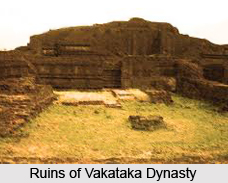 History of Dhule district goes back a long way. The District of Dhule was previously known as West Khandesh district. The ancient name of this region was Rasika. Earlier, when King Senuchandra of the Yadava dynasty was in power, it came to be called Seunadesa. Subsequently its name was changed to Khandesh to suit the title Khan given to the Faruqi kings by Ahmad I of Gujarat. When the Aryans invaded the Deccan, Agastya was the first Aryan to cross the Vindhya mountain range and reside on the banks of the Godavari River. This territory came to be included in the empire of Emperor Ashoka. Pusyamitra Sunga, the founder of the Sunga dynasty overthrew the Maurya dynasty. Later on, the Satavahana dynasty ruled over the region. About A.D. 250, the Satavahans were supplanted by the Abhiras in Western Maharashtra (Regan Isvarsena). The names of feudatories of Abhiras who ruled in Khandesh have been known from the copperplates discovered at Kalachala (Gujarat) and Cave X5II of the Ajanta caves. After the downfall of the Satavahans, the Vakataka dynasty rose to power in Vidarbha. The Vakatakas were overthrown by the Rashtrakuta dynasty. This region was rulled by the Chalukyas of Badami and subsequently the Yadavas of Devagiri.
History of Dhule district goes back a long way. The District of Dhule was previously known as West Khandesh district. The ancient name of this region was Rasika. Earlier, when King Senuchandra of the Yadava dynasty was in power, it came to be called Seunadesa. Subsequently its name was changed to Khandesh to suit the title Khan given to the Faruqi kings by Ahmad I of Gujarat. When the Aryans invaded the Deccan, Agastya was the first Aryan to cross the Vindhya mountain range and reside on the banks of the Godavari River. This territory came to be included in the empire of Emperor Ashoka. Pusyamitra Sunga, the founder of the Sunga dynasty overthrew the Maurya dynasty. Later on, the Satavahana dynasty ruled over the region. About A.D. 250, the Satavahans were supplanted by the Abhiras in Western Maharashtra (Regan Isvarsena). The names of feudatories of Abhiras who ruled in Khandesh have been known from the copperplates discovered at Kalachala (Gujarat) and Cave X5II of the Ajanta caves. After the downfall of the Satavahans, the Vakataka dynasty rose to power in Vidarbha. The Vakatakas were overthrown by the Rashtrakuta dynasty. This region was rulled by the Chalukyas of Badami and subsequently the Yadavas of Devagiri.
In A.D. 1296, Ala-ud-din Khilji invaded the territory, and Ramachandra Yadava who ruled the area had to pay a heavy ransom. His son Sankaragana discontinued sending the stipulated tribute to Delhi and was defected and slain by Malik Kafur in A.D.1318. In 1345, Devagiri passed into the hands of Hasan Gangu, the founder of Bahamani dynasty. However, Khandesh formed the southern boundaries of the Tughluq Dynasty.
In 1370, Firuz Shah Tughluq assigned the district of Thalner and Karavanda to Malik Raja Faruqui, the founder of the `Faruqui` dynasty. His family claimed descent from the Khaliph Umer Faruq. He established himself at Thalner. The Governor of Gujarat honored Malik Raja with the little `Sipahsalar of Khandesh`. From the title Khan the region came to be known as `Khandesh` the country of Khan. During thie time, a rich Ahir chief, despite his wealth, acknowledged the supremacy of Malik Raja, and bequeathed Laling to his elder son Malik Nasir and Thalner to Malik Iftikar. Malik Nasir built two cities on the bank of the Tapi River. The one on the east bank was called Zainabad, and the one on the west bank was called Burhanpur after Saikh Burhanuddin of Daulatabad. Burhanpur became the capital of the Faruqui dynasty. In 1917 Malik Nasir defected his younger brother Malik Iftikar.
On 6th January 1601 Khandesh came under Akbar`s rule. Khandesh was named by Akbar as `Dandes` after his son Daniyal. In 1634 Khandesh was made into a Suba. In 1723, Nizams-ul- Mulk Asaf Jah I who was the Mughal governor of Malva revolted against that power and became independent. He died in 1798. His son Salabat Jung was Nizam in 1752 when he was defeated by the Marathas at Bhalki. As per the terms of the treaty of Balki, practically the whole of Khandesh came under the control of the Marathas and remained so until 1818. Balaji Balvant looked to the administration of Dhulia and fixed his headquarters here. He continued to exercise has authority till 1818, in which year the country passed to the British.
In 1819 captain Briggs, the first political agent, probably for its central position and because it was on the high road between Pune and Hindustan, made Dhulia the district headquarter. The town was then very small. When Captain Briggs took over, the town had only three divisions, viz old Dhulia , Devpur and Moglai, New Dhulia and Peth previously known as Brigg`s peth being his creations. Merchants and others were invited from Burhanpur, master carpenters and smiths were brought from Mumbai, Surat and a residence and three offices were built. Dhulia was once again put on the way of prosperity.
In the year 1906 for administrative purposes, Khandesh was divided in to two districts known as West Khandesh and East Khandesh. West Khandesh retained Dhulia, Nandurbar, Navapur, Peta, Pimpalner, Shahada, Shirpur, Sindkheda and Taloda talukas of the old Khandesh district. In 1960 Dhule became a part of Maharashtra state from old Bombay state. On 1st July 1998, Dhule district was divided to form two separate districts- Dhule district and Nandurbar. Dhule district today has four talukas- Dhule, Sakri, Shirpur and Shindkheda- with Headquarters at Dhule.



















